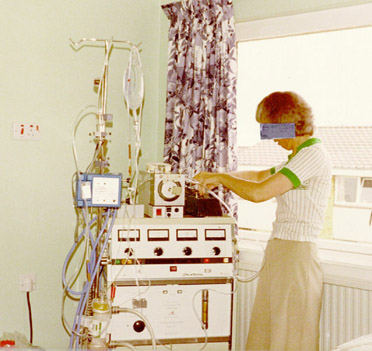In 1967, the Scottish Home and Health Department granted £8500 to the Regional Hospital Board to fund a pilot scheme that provided dialysis machines for patients to use at home, following Dr Robson’s suggestion (Catford EF, 1984). This program was suitable for patients who were physically fit enough and could learn to control their own treatment after a training period.
| Letter from the secretary to the treasurer regarding the provision of home dialysis apparatus. Fom the Lothian Health Service Archive, with permission.
Click here to show (note: large and slow-loading images on page) |
A room in the patient’s home had to be converted and specially adapted to accommodate the dialysis machine that was provided by the hospital. If no such room were available, a small portable hut (Portakabin) would be placed next to the home. The conversion takes about 4-6 months. In September 1967, the first home HD machine, an RSP machine, was installed in an Edinburgh home. By February 1969, three patients were on home HD (Catford EF, 1984). Patients on home HD attended a medical review every 3 months. Technical and nursing help was provided whenever required.
RSP dialysis machines were fitted with warning and fail-safe devices, and the patients or their families were given a contact telephone number should emergencies arise. A technician would go to their homes to rectify technical problems. The RSP machines were more sophisticated than the Kolff-Travenol twin coil machines. The RSP machines had a 123-litre tank, where electrolytes were mixed with water and was pumped into an upper chamber. The electrolytes bathed the artificial kidney like a fountain. The RSP machines did not require the changing of dialysate every 2 hours. The conductivity of the electrolytes had to be carefully checked.
Home HD cost less than hospital HD, and it was claimed that treatment of the patient himself ( often attended by the spouse) can reduce the cost by 50% (Robson JS, 1969). Home HD also released hospital HD time for other patients and gave home HD patients more flexibility in managing their own time. Instead of taking time off work to go to the hospital for dialysis, they could go to work and dialyse when they are off work. Patients could also learn how to cannulate themselves. A member of the family was usually trained to be able to set up the dialysis machine. Moreover, the total number of patients dialysed was not limited to the number of stations that could be provided by the hospital. The frequency of dialysis could be increased to 3 times a week, which is more ideal than twice a week at the hospital. One unforeseeable use of home HD was the provision of this service to dialysis patients who recovered from hepatitis, to help to contain the hepatitis outbreak in 1969 and 1970.

A patient setting up her home haemodialysis machine (Dylade D2 machine) in the 1980s (kindly provided by Sister Sylvia Green)
The number of patients who went on home HD kept growing. In the late 1970s, about 80 patients were on home HD. By 1981, there were 90 patients receiving home HD.
Home HD was at its peak in the 1970s to 1980s. Its popularity later declined with the advent of CAPD, as transplantation became more successful and when some patients returned to hospital HD as they got older. Home HD puts a lot of pressure on the patients, their partners and the family.
The Redy machine
The Redy machine was used for a limited period. It was semi-portable and was suitable for younger patients (under 45) who were waiting for transplantation. No home adaptation was needed. Older patients awaiting transplantation would be placed on standard home dialysis. The Redy machine was also used on those who were going on holiday.
It used 5.5 litres of water and re-regenerated the dialysis fluid in a charcoal column. (Hospital HD used 180 litres of water for each dialysis). The charcoal column would convert urea to ammonia. The toxins went into a cartridge and clean water was re-cycled. It was not very efficient.

A cheque and a Redy Machine was being presented to the staff of the Renal Unit: Dr Robin Winney (backrow left), Sister Sylvia Green (backrow right) (1980s) (kindly provided by Sister Sylvia Green)

